The Battle of the River Plate
An innovative design and heavy armament was not enough to save the Graf Spee from its British pursuers
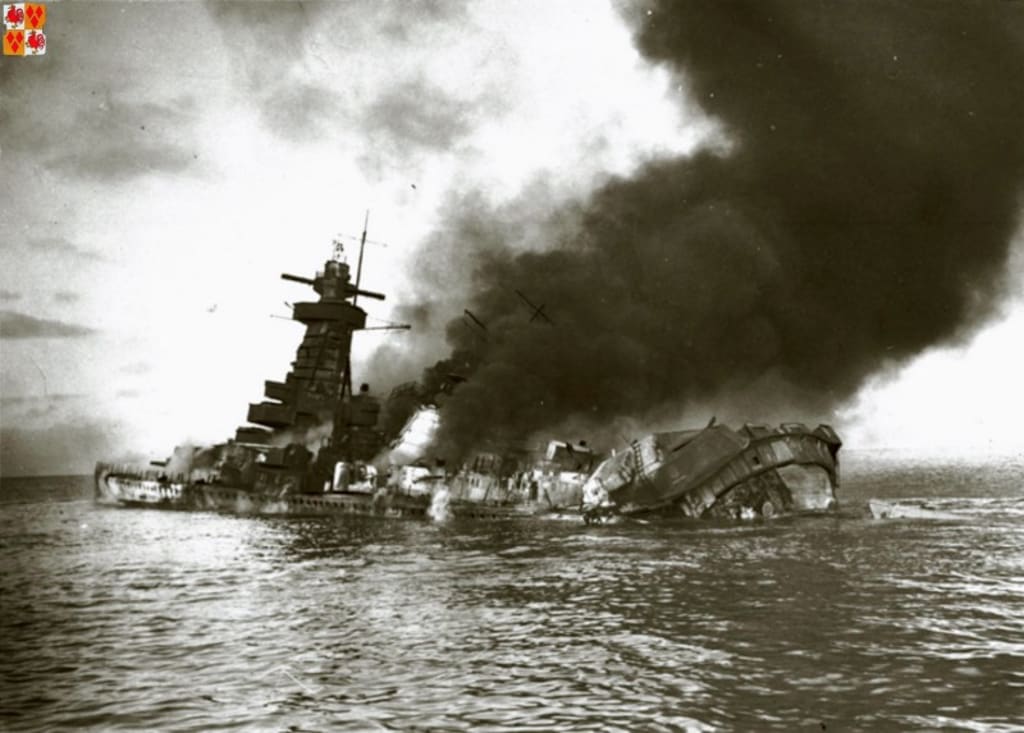
Why this story?
I've had an interest in this battle for many years as I knew a man called Jack Lewis, who had served on HMS Exeter as a humble stoker during the battle. Jack was a larger-than-life character whose later careers included being a farmer, a milkman, a scrap merchant and pig-breeder. He always wore wellington boots when I knew him. I had hoped to visit the River Plate one day in my boat, but it looks like the Covid pandemic has now put paid to that plan.
The Battle of the River Plate was a naval battle fought on December 13, 1939, during the early stages of World War II. It pitted the Royal Navy's HMS Exeter, HMS Ajax, and HMS Achilles against the Kriegsmarine's Admiral Graf Spee. The battle took place in the South Atlantic, off the coast of South America, near the mouth of the Rio de la Plata.
The Admiral Graf Spee, a German heavy cruiser, had been causing havoc in the South Atlantic, attacking and sinking numerous Allied merchant ships. In response, the British dispatched the HMS Exeter, HMS Ajax, and HMS Achilles to hunt down and engage the Admiral Graf Spee.
The Admiral Graf Spee
It was named after Admiral Maximilian von Spee, a German naval officer who died at the Battle of the Falkland Islands during World War I. The cruiser was a Deutschland-class "Panzerschiff", nicknamed a "pocket battleship" by the British.
The ships of the class, Deutschland - the Admiral Scheer, and Admiral Graf Spee, were all stated to displace 10,000 long tons (10,160 t) in accordance with the Treaty definitions, though they actually displaced 10,600 to 12,340 long tons (10,770 to 12,540 t) at standard displacement.
The Admiral Graf Spee was built in the mid-1930s, at a time when Germany was rapidly rearming and expanding its navy and was a highly innovative ship in many ways.
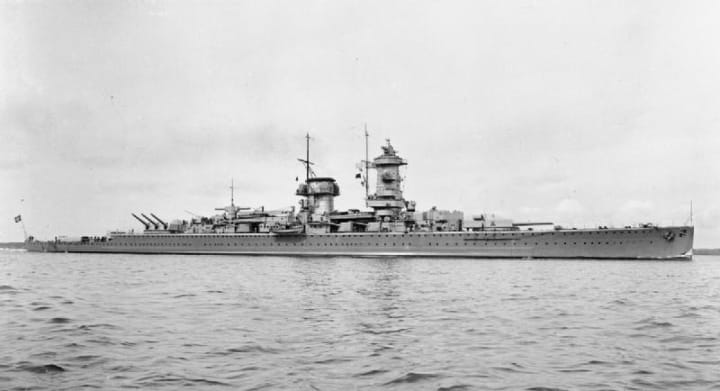
Importance of a welded hull
The new class of ships had a welded hull construction. The use of welded construction, rather than traditional riveting, was a relatively new development in shipbuilding at the time which Germany had developed to get around the weight limitations placed on its naval ship building by the Treaty of Versailles. Welding allowed for a stronger and more streamlined hull, with fewer seams and less weight.
The Treaty of Versailles was, of course, a key motivator for Adolf Hitler as he believed that Germany was being too heavily punished by the Allies after World War 1.
By welding and therefore avoiding the use of rivets, many tons were saved in the Graf Spee's construction. Germany could builder larger ships but still stay with the bounds set by the Treaty.
The Admiral Graf Spee was one of the first major warships to be built with a welded hull.
Propulsion
This, too, was innovative. The Admiral Graf Spee was driven by a propulsion system equipped with two sets of four 9-cylinder, double-acting, two-stroke diesel engines built by MAN. The adoption of an all-diesel propulsion system was a radical innovation at the time and contributed to significant savings in weight. Each set was controlled by transmissions built by AG Vulcan. The engine sets were paired on two propeller shafts.
Armament
In terms of armaments, the Admiral Graf Spee was considered to be heavily armed with a main battery of six 15-inch (380 mm) guns mounted in two triple gun turrets. It also had a secondary battery of eight 5.9-inch (150 mm) guns, as well as numerous smaller weapons for defense against aircraft and smaller ships.
Radar
The Admiral Graf Spee was one of the first German warships to be equipped with state-of-the-art radar (an experimental FuMO 22) and communications systems, which helped it to locate and track enemy ships at long range.
Range
According to some estimates, the ship had a range of approximately 10,000 nautical miles (18,500 km) at a cruising speed of 15 knots (28 km/h). This would have allowed it to operate for extended periods of time without needing to resupply. The resupply operations (fuel oil, ammunition, food) of the Admiral Graf Spee during World War II are not well documented.
The Admiral Graf Spee saw action in the early stages of World War II, operating in the South Atlantic and Indian Oceans. It was responsible for sinking numerous Allied merchant ships, causing havoc in shipping lanes and disrupting the flow of trade.
The British force
The Royal Navy assembled nine forces to search for the surface raider. It was Force G that found and chased the Graf Spee. Force G, the South American Cruiser Squadron, comprised the County-class heavy cruiser HMS Cumberland, the York-class heavy cruiser HMS Exeter and two Leander-class light cruisers, HMS Ajax and Achilles.
The British ships
HMS Exeter was a York-class heavy cruiser that had been commissioned in 1930. It was armed with a main battery of eight 8-inch (200 mm) guns, as well as a number of smaller weapons for defense against aircraft and smaller ships. The Exeter was capable of a top speed of 32 knots (59 km/h) and had a range of approximately 8,000 nautical miles (15,000 km).
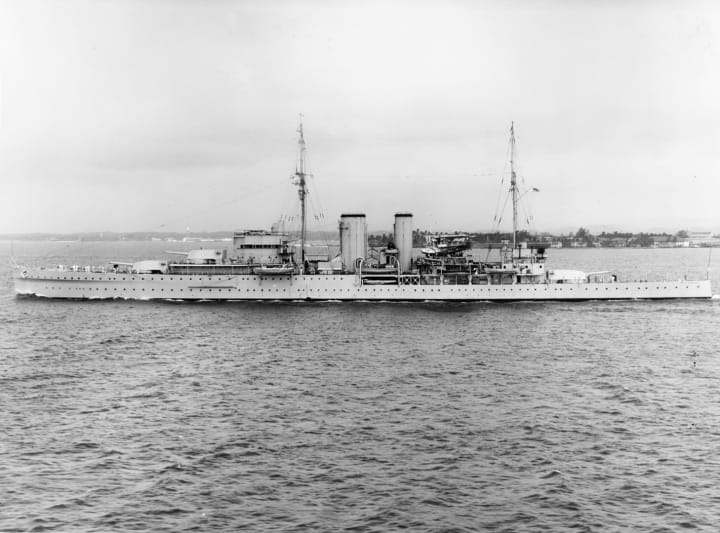
HMS Ajax was a Leander-class cruiser that had been commissioned in 1933. It was armed with a main battery of eight 6-inch (152 mm) guns, as well as a number of smaller weapons for defense against aircraft and smaller ships. The Ajax was capable of a top speed of 32 knots (59 km/h) and had a range of approximately 8,500 nautical miles (16,000 km).
HMS Achilles was a Leander-class cruiser that had been commissioned in 1933. It was armed with a main battery of eight 6-inch (152 mm) guns, as well as a number of smaller weapons for defense against aircraft and smaller ships. The Achilles was capable of a top speed of 32 knots (59 km/h) and had a range of approximately 8,500 nautical miles (16,000 km).
HMS Cumberland was built in 1926. According to the builders she was 10,000 tons displacement and capable of over 32 knots (59.73 km/h). Her main armaments were 8 × 8 in (203 mm) dual guns and 4 × 4 in (102 mm) single AA guns. She was in the Falkland Islands for maintenance but put to sea as soon as the Graf Spee had been located and joined the other ships after 34 hours, missing the actual battle.
The battle of the River Plate
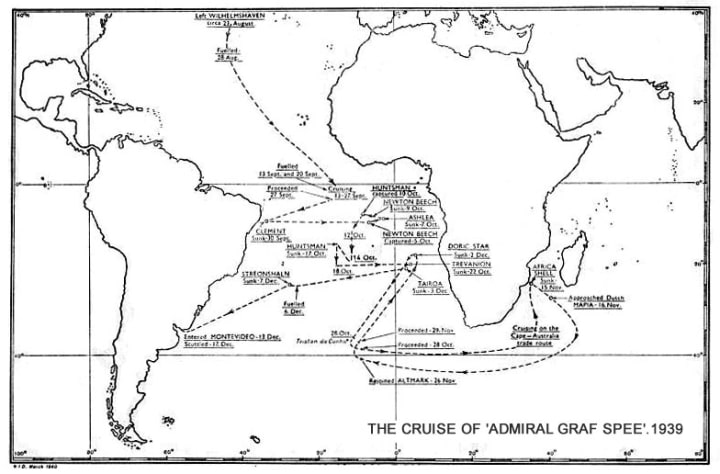
The battle began early in the morning of 13 December 1939, with the Admiral Graf Spee firing the first shots. The Exeter was severely damaged in the opening salvos, and was forced to withdraw from the battle. The Ajax and Achilles, however, managed to hold their own against the German cruiser.
The battle raged on for several hours, with both sides suffering heavy damage and casualties. The Admiral Graf Spee was hit by numerous shells, and caught fire in several places. Despite this, the German cruiser continued to fight on, causing more damage to the British ships.
As the battle wore on, it became clear that the Admiral Graf Spee was in trouble. The ship's captain, Hans Langsdorff, realized that he could not win the battle and decided to retreat. He sailed the damaged cruiser into the neutral port of Montevideo, in Uruguay, seeking to make repairs and avoid capture.
Diplomatic wrangling
There was much diplomatic wrangling. In Montevideo, the 13th Hague Convention came into play. Under Article 12, "belligerent war-ships are not permitted to remain in the ports, roadsteads or territorial waters of the said Power for more than twenty-four hours". Under Article 14, "[a] belligerent war-ship may not prolong its stay in a neutral port beyond the permissible time except on account of damage" (Wikipedia)
The end
The British, however, were not willing to let the Admiral Graf Spee escape from its safe haven. They blockaded the port and demanded that the ship be interned or handed over to them. Langsdorff, fearing that his ship would be seized and his crew taken prisoner, decided to scuttle the Admiral Graf Spee. He ordered his crew to abandon ship, and then set the charges that would sink the cruiser.
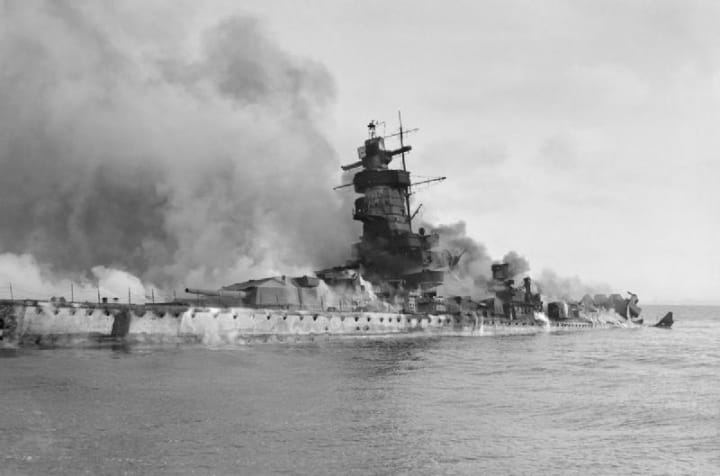
The Admiral Graf Spee sank on December 17, 1939, bringing an end to the Battle of the River Plate. While both sides had suffered heavy losses and damage, the British emerged as the clear winners. The sinking of the Admiral Graf Spee was a major victory for the Allies and a blow to the Kriegsmarine.
Hitler was furious about the scuttling, and Captain Langsdorff shot himself on 19 December.
In total, 108 sailors were killed in the action.
The Battle of the River Plate was a significant event in the early days of World War II. It marked the first major naval engagement of the war and showed that the Royal Navy was still a formidable force, raising morale in the UK as the public realised that the war would not 'be over by Christmas'.
The battle had a lasting impact on the war in the South Atlantic. It demonstrated that the Allies were willing to take the fight to the Germans, and that the Kriegsmarine was not invulnerable. It also served as a warning to other German ships operating in the area, and helped to deter further attacks on Allied merchant ships.
RIP Jack Lewis.
***

About the Creator
James Marinero
I live on a boat and write as I sail slowly around the world. Follow me for a varied story diet: true stories, humor, tech, AI, travel, geopolitics and more. I also write techno thrillers, with six to my name. More of my stories on Medium
Enjoyed the story? Support the Creator.
Subscribe for free to receive all their stories in your feed. You could also pledge your support or give them a one-off tip, letting them know you appreciate their work.


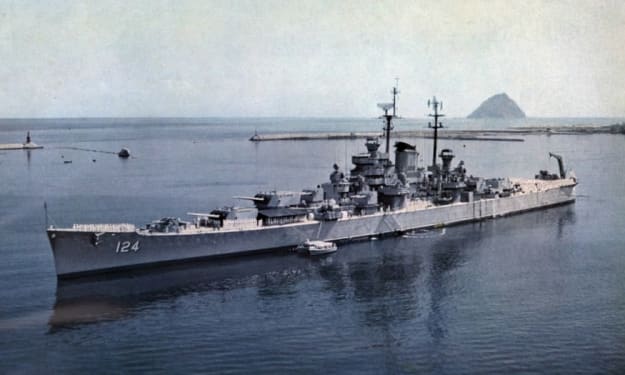



Comments
There are no comments for this story
Be the first to respond and start the conversation.